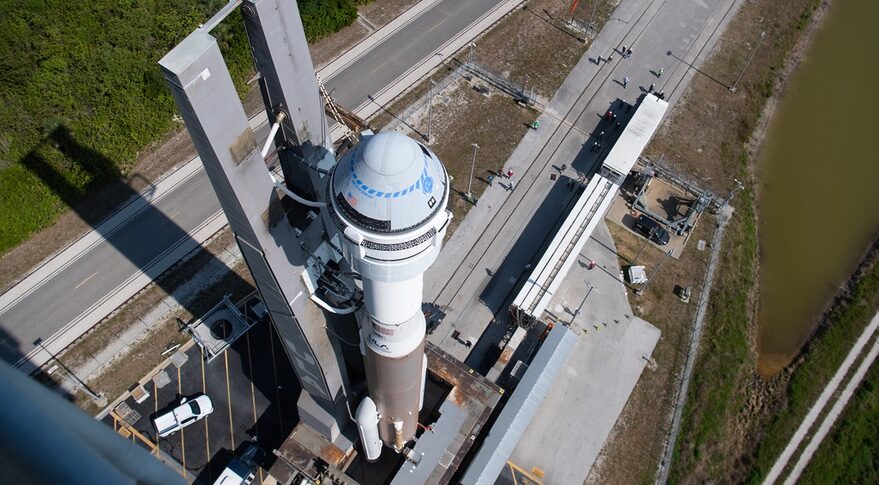KENNEDY SPACE CENTER, Fla. — Boeing’s CST-100 Starliner spacecraft is ready to attempt another uncrewed test flight to the International Space Station, with both the company and the agency expressing confidence in the spacecraft despite past problems.
The Starliner spacecraft, atop a United Launch Alliance Atlas 5 rocket, rolled out to the pad at Space Launch Complex 41 at Cape Canaveral, Florida, May 18. Launch of the spacecraft on the Orbital Flight Test (OFT) 2 mission remains scheduled for 6:54 p.m. Eastern May 19.
At prelaunch briefings here, NASA and Boeing officials said they were not dealing with any technical issues ahead of the launch, and weather forecasts project a 70% chance of acceptable conditions for launch. A backup launch opportunity is available May 20 at 6:32 p.m. Eastern, although weather forecasts project only a 30% chance of acceptable weather.
According to the mission plan, Starliner will dock with the station about 24 hours after liftoff. It will remain there for several days for tests before undocking and landing at White Sands Space Harbor in New Mexico. The mission will last 5 to 10 days, depending in part on weather conditions at the landing site.
This will be the second attempt to launch OFT-2. The initial launch in August 2021 was scrubbed hours before liftoff when propellant valves in the spacecraft’s service module failed to open when commanded. Engineers found that the valves had corroded shut, causing a long-term delay of the mission. NASA and Boeing later concluded that nitrogen tetroxide propellant, seeping through the valve’s Teflon seal, reacted with ambient moisture to create nitric acid that corroded aluminum elements of the valve.
This mission comes nearly two and a half years after the original OFT mission in December 2019. The spacecraft suffered problems immediately after separation from the rocket because a mission events timer in the spacecraft was improperly set. Engineers also discovered a software problem that could have caused the spacecraft’s service module to bump back into the crew module after separation just before reentry, fixing it with only hours to spare.
The OFT-2 mission will confirm those issues have been fixed. Mark Nappi, vice president and program manager of the commercial crew program at Boeing, said at a May 17 briefing that spacecraft controllers have been regularly cycling the valves to ensure they are not corroding. “They all operated nominally, so we’re in good shape,” he said.
The spacecraft will also carry out tests that the truncated OFT mission could not, in particular approaching and docking with the ISS. “We’re going to be paying attention to the artificial vision system, called VESTA, which we didn’t get a chance to see in action on the first Orbital Flight Test,” said Mike Fincke, a NASA astronaut who is among those training for future Starliner missions, at a May 18 briefing. VESTA, or Vision-based Electro-optical Sensor Tracking Assembly, helps the spacecraft identify the space station and approach it.
There will be tests once Starliner is docked with the station, including work by space station astronauts Kjell Lindgren and Bob Hines. Fincke said they will test various Starliner systems, such as communications handsets and microphones. “There are a lot of things with the interface to the International Space Station that the space station crew will help us with.”
A successful OFT-2 mission would allow NASA to proceed with a test flight with astronauts on board, called the Crew Flight Test (CFT). That could launch as soon as the end of the year, although agency officials were reluctant in prelaunch briefings to set a schedule for CFT.
“We are getting our Crew Flight Test vehicle ready to go by the end of the year,” Kathy Lueders, NASA associate administrator for space operations, said May 18. That schedule will depend on both resolving any issues that arise on OFT-2 as well as the schedule of other ISS missions.
“We need to make sure there isn’t anything we need to fix or update on the spacecraft that we’re planning to have ready by the end of the year, and then lay out the full schedule for everybody,” she said, adding that the agency should know this summer both the schedule for CFT as well as who will fly it and how long the mission will last.
There may still be work to do even after a successful OFT-2 mission. At a meeting of NASA’s Aerospace Safety Advisory Panel May 12, David West, a member of the panel, warned that Boeing’s work certifying Starliner’s parachutes was lagging behind schedule, but didn’t elaborate. He also said the panel was concerned that Boeing staffing levels on the program were “especially low,” particularly given the amount of work needed to get ready for the CFT mission after OFT-2.
Nappi said May 17 that he believed the panel’s concerns were with certification for operational, or post-certification, missions after CFT. “We do have some testing planned this summer with NASA” on the parachutes, he said. “The results of that will obviously lead to certification.”
Butch Wilmore, another NASA astronaut who is training for early Starliner missions, exuded confidence in the spacecraft despite past problems and the possibility of new problems, or “unknown unknowns,” on this mission. “We wouldn’t be here right now if we weren’t confident that this would be a successful mission,” he said at a May 18 briefing alongside Fincke and Suni Williams, another NASA astronaut.
“We’re ready,” he said. “This spacecraft is ready. These teams are ready. Boeing is ready. ULA is ready. The mission ops folks who will control the spacecraft in space are ready, and we’re excited.”

